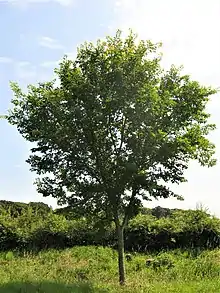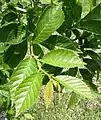Ulmus 'Morton Glossy' = Triumph
Ulmus 'Morton Glossy' (selling name Triumph™) is a hybrid cultivar raised by the Morton Arboretum, Illinois. Originally named 'Charisma' until it was realized that name had already been registered for another plant, the tree was derived from a crossing of two other hybrid cultivars grown at the Morton: Accolade and Vanguard. Tested in the US National Elm Trial coordinated by Colorado State University, Triumph averaged a survival rate of 86% after 10 years.[1] Triumph was introduced to the UK in 2006 by the Frank P. Matthews nursery in Worcestershire.[2]
| Ulmus 'Morton Glossy' = Triumph | |
|---|---|
 Triumph aged 20 years, Boarhunt, UK | |
| Genus | Ulmus |
| Hybrid parentage | 'Morton' = Accolade × 'Morton Plainsman' = Vanguard |
| Cultivar | 'Morton Glossy' = Triumph |
| Origin | US |
Description
Triumph has been promoted in the United States as "strong and symmetrical" in growth and habit . However, its performance in the southern United States has not impressed, and it was dismissed as "ugly" by Michael Dirr, Professor of Horticulture at the University of Georgia , on account of its "wild" growth and splaying branches. It is similar in stature to the American Elm and has leaves that are a deep glossy green when mature, < 10 cm in length by 5 cm broad, with rough upper surface and finely toothed margins. In trials in the UK, Triumph was found to be the first elm to flush in spring, and the first to shed its leaves in the fall, usually by early October. The tree grew poorly on thin soils over clay, which became very dry in summer, but excelled on floodplain alluvium subjected to brief periods of inundation in winter.[2]
 Foliage in midsummer
Foliage in midsummer Bark of 20-year-old tree
Bark of 20-year-old tree
Pests and diseases
Triumph has a resistance to Dutch elm disease, but is highly susceptible to attack by elm leaf beetle Xanthogaleruca luteola [3] and Japanese beetle.[4][5]
Cultivation
In commerce, Triumph is usually propagated by grafting onto an Ulmus pumila rootstock. The tree, under its original name of 'Charisma', featured in the elm trials conducted by Northern Arizona University at Holbrook, eastern Arizona. Triumph is very cold-hardy; in artificial freezing tests at the arboretum [6] the LT50 (temp. at which 50% of tissues die) was found to be - 40 °C.
The tree is currently being evaluated in the National Elm Trial coordinated by Colorado State University. Triumph was briefly in commerce in the UK, where 180 trees were sold in 2006; several specimens were acquired for assessment by Butterfly Conservation in Hampshire.[2]
Synonymy
- 'Charisma': initial name accorded until 1995.
Accessions
- North America
- Arnold Arboretum, US. Acc. no. 132–2002
- Bartlett Tree Experts, US. Acc. nos. 2001–104, 2001–105
- Bickelhaupt Arboretum, US. Acc. no. 02–038
- Chicago Botanic Garden, US. Planted in the Parking Lots, no other details available.
- Dawes Arboretum , US. 3 trees. No acc. details available.
- Morton Arboretum, US. Acc. nos. 135–94, 523–99, 212–2004, 497–2004, 630–2004, 1090–2004.
- Parker Arboretum, US. No acc. details.
- University of Idaho Arboretum, US. Two trees. Acc. no. 2000091
- Europe
- Grange Farm Arboretum, UK. Acc. details not known.
- Sir Harold Hillier Gardens, UK. Acc. no: 2007.0260
- Royal Botanic Garden Edinburgh, UK. Acc. no. 20070379
Nurseries
- North America
- Acorn Farms , Galena, Ohio, US.
- Bailey Nurseries , St. Paul, Minnesota, US.
- Carlton Plants, LLC , Dayton, Oregon, US.
- Charles J. Fiore , Prairie View, Illinois, US.
- J. Frank Schmidt & Son Co. , Boring, Oregon, US.
- Johnson's Nursery , Menomonee Falls, Wisconsin, US.
- North American Plants , Lafayette, Oregon, US.
- Sester Farms , Gresham, Oregon, US.
- Sun Valley Garden Centre , Eden Prairie, Minnesota, US.
References
- Griffin, J.; et al. (2017). "Ten-Year Performance of the United States National Elm Trial" (PDF). Arboriculture & Urban Forestry. International Society of Arboriculture, Atlanta, US. 43(3):107–120.
- Brookes, A. H. (2020). Great Fontley Elm Trial, 2020 Report. Butterfly Conservation, Lulworth, UK.
- McPherson, G. et al. (2008). National elm trial: Initial report from Northern California. Western Arborist, Fall 2009, 32–36.
- Giblin, C. P. & Gillman, J. H. (2006). Elms for the Twin Cities: A Guide for Selection and Maintenance. University of Minnesota.
- Brady, C., Condra, J., & Potter, D. (2008) Resistance of Landscape-suitable Elm (Ulmus spp.) Cultivars to Japanese Beetle, Leaf Miners, and Gall Makers. 2008 Research Report, Nursery & Landscape Program, pp 15, 16. University of Kentucky.
- Shirazi, A. M. & Ware, G. H. (2004). Evaluation of New Elms from China for Cold Hardiness in Northern Latitudes. International Symposium on Asian Plant Diversity & Systematics 2004, Sakura, Japan.
External links
- http://fletcher.ces.state.nc.us/programs/nursery/metria/metria11/warren/elm.htm Warren, K., J. Frank Schmidt & Son Co. (2002). The Status of Elms in the Nursery Industry in 2000.
- http://www.mortonarb.org/plantinfo/plantclinic/phc/New-Elms-For-The-Landscape.pdf. Miller, F. (2002). New elms for the landscape and urban forest.
- http://www.hfrr.k-state.edu/DesktopModules/ViewDocument.aspx?DocumentID=1619 Dutch Elm Disease - . Kansas State University.
